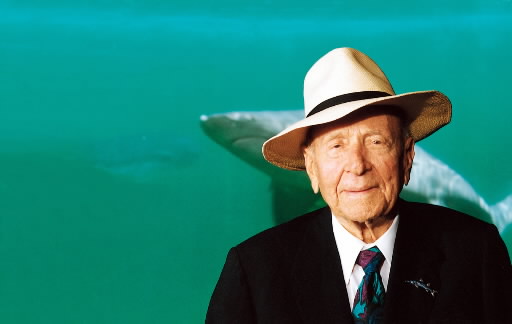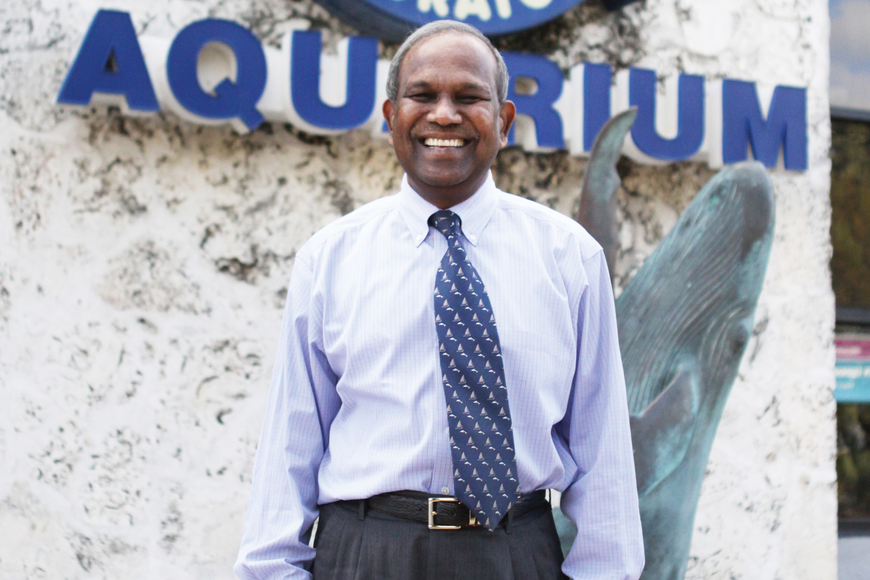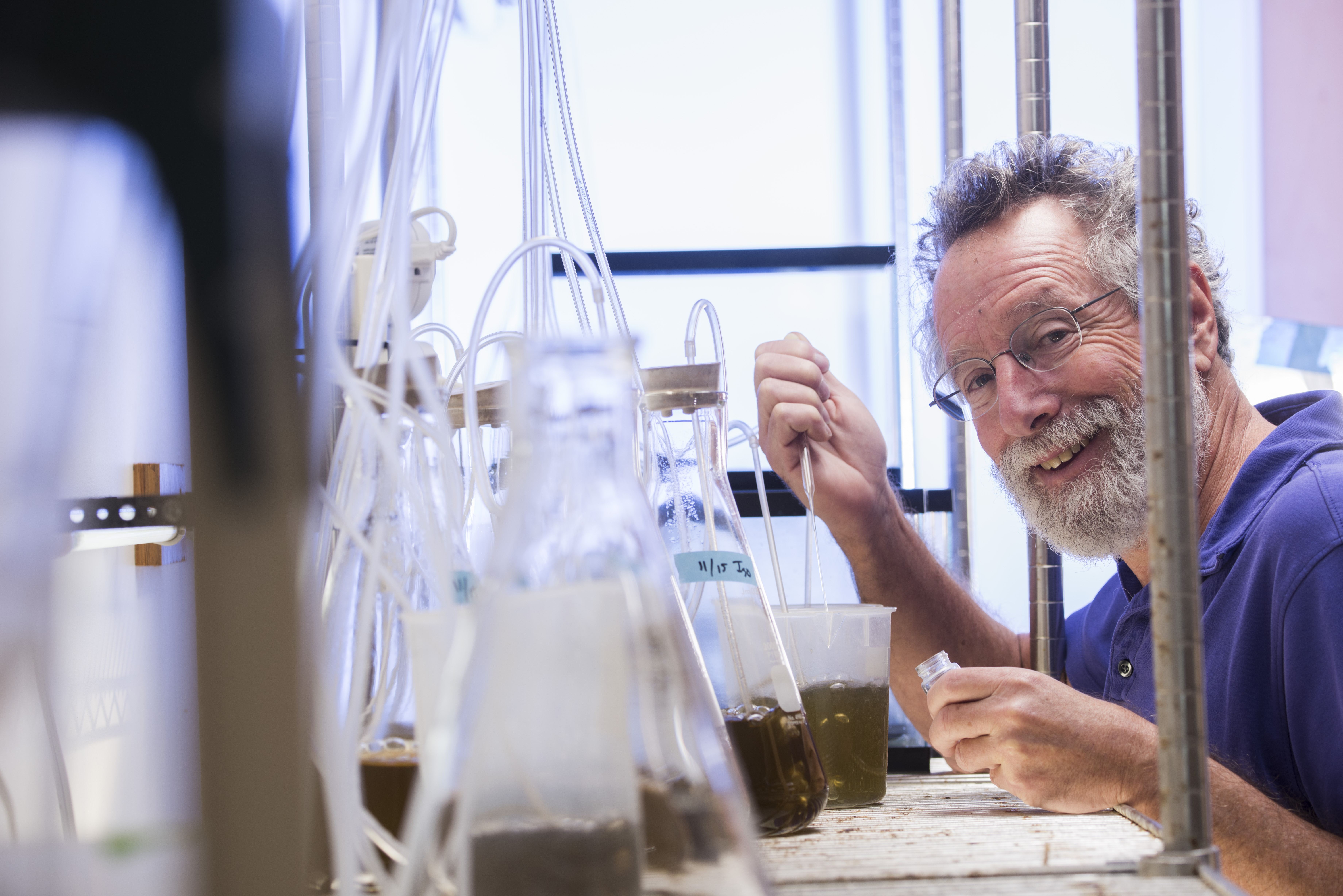Mote endowment advancing research in marine science
William R. Mote’s entrepreneurial brilliance is obvious to anybody who’s ever passed an 18-wheeler on Interstate 95. The restless boy who spent the dawn of the 20th century crabbing and fishing Tampa Bay eventually headed to New York and developed a container that was easy to load from ship to truck.

But commerce and transportation were never Mote’s biggest passion, even though they made him rich. Those who knew Mote, or visit the world-class research center and aquarium in Sarasota that bears his name, or those who benefit from the William R. and Lenore Mote Endowment at Florida State University’s Department of Biological Science, know his first love was the sea.
“He was a good friend of mine, a mentor and a father figure. I knew him for 20 years,” said Kumar Mahadevan, president emeritus and senior scientist at Mote Marine Laboratory & Aquarium, and a co-trustee of Mote’s estate. “One of his dreams was to build a barge where on one side, scientists would be working, and the other side would be he and his buddies fishing. He saw the connection between science and the importance of the resource.”
Mahadevan was a budding chemical engineer at Madras University in 1967 in his native India when came across conservationist Rachel Carson’s epic writings and became smitten by oceanography. After earning his master’s degree in marine biology in Annamalai University, he came to the United States and earned a Ph.D. in biological oceanography at FSU in 1977.

Mote Marine Laboratory & Aquarium
Mahadevan’s academic training and impeccable timing gave him a front-row seat to the development of a nascent discipline as well as working relationships with its pivotal figures, including Mote, undersea explorer Sylvia Earle, and noted ichthyologists Eugenie Clark, Perry Gilbert and Charles Breder.
Mote died at the age of 93 in 2000, and Mahadevan retired four years ago, but their contributions to the science thrive even as the oceans they sought to protect grow more imperiled every year. It was Mahadevan who urged Mote to forge a relationship between the marine center and FSU, introducing the entrepreneur to former FSU President Sandy D’Alemberte and then-Provost Larry Abele, who was also a marine biologist.
FSU already had a strong artistic presence in Sarasota through the Asolo Theater and the Ringling Museum, Mahadevan said, so why not extend the reach to marine science as well?
“Mr. Mote’s interest was primarily in fisheries enhancement, and Mote was already engaged in several fisheries programs,” Mahadevan said. “FSU did not have a strong fisheries program, but had one of the nation’s best theoretical ecology programs. So we reasoned that by combining the strengths of the two organizations, we could develop a very strong fisheries program based on a theoretical ecology basis.”
Mote’s response was a $1 million donation, matched by the state, and the creation of the William R. and Lenore Mote Endowment, named in honor of Mote’s wife, in 1994. FSU acknowledged Mote’s gift and contributions to science with an honorary degree.

FSU faculty and administrators say the endowment has been a boon for the university and marine science ever since.
Felicia Coleman, director of FSU’s Coastal and Marine Laboratory, also counted Mote as a close friend. Coleman remembers a gentleman, an avid fisherman and a marine science junkie whose favorite species was snook.
Coleman said Mote money allows graduate students to conduct summer research unfettered by other responsibilities. One, Chris Malinowski, is focusing on the rare Goliath grouper, a species that can grow to 800 pounds or more. Once plentiful, the Goliath grouper has been nearly wiped out by overfishing, Coleman says.
The Goliath grouper is making a comeback in South Florida, Coleman says, and regulators are under pressure to open the fishery. But there’s a problem — Goliath grouper bioaccumulate methyl mercury, posing a significant health hazard to anyone who eats them. Malinowski, who is pursuing his doctorate, is studying their diet to discover the source, Coleman says.
“It’s critical that our graduate students recognize when their work has policy implications and have the tools they need to take that information forward into the policy arena,” she said. “This is certainly in keeping with Mr. Mote’s interest in giving something back to the oceans.”

Professor of Biological Science Don Levitan says the Mote endowment, like the marine organisms it was designed to study and protect, has evolved.
Initially, FSU and Mote Marine Lab administrators shared responsibility for bringing in an eminent scholar who would spend a year on campus or in Sarasota. But Levitan says it became harder and harder to find a suitable candidate who could dedicate that much time.
“So a couple of years ago, the college split that fund into three components,” he said. “One component goes to the Mote Laboratory, one goes to the College of Arts and Sciences and biology department, and one component goes to the Mote Symposium every three years.”
Now, the endowment supports one of the most innovative programs at FSU, Levitan says, the Mote Working Group.
Mote funds pay for an annual, week-long beach retreat in an isolated coastal location that Levitan says provides a distraction-free opportunity for international scholars, FSU faculty and graduate students to focus on the hottest topics in marine science.
So far, the scientific retreats have taken place on St. George Island and Cape San Blas. Levitan says the working groups generate published research that has been well received and are filling an important niche.

“Usually when scientists attend big conferences, they meet with colleagues and briefly touch on subjects, but don’t have the time or the opportunity to work together to advance the field,” Levitan said. “But having these intensive interactions while living and working together for a week, provides a unique chance to delve deeply into these subjects and make substantial progress. It’s been really remarkable.”
The first working group topic was “metabolic scaling and modular organisms,” which has to do with corals, how they divide and how their metabolisms correlate to their growth.
“We reviewed the available data and discovered that larger corals are often more efficient at requiring energy and allocating it to growth and reproduction than smaller corals, and this is important because it influences the way that organisms respond to bleaching and how they recover from other stresses, like hurricanes,” said FSU Assistant Professor of Biological Science Scott Burgess, a member of the Mote Working Group. “The abundance and sizes of corals influences how much energy the population requires to recover.”
It’s an important question, Burgess says, at a time when global warming is amplifying bleaching cycles along the Great Barrier Reef in Burgess’ native Australia.
“I can’t stress enough the importance of this endowment and endowments like it for providing these really unique opportunities for researchers at FSU to be leaders in their field,” Burgess said.

